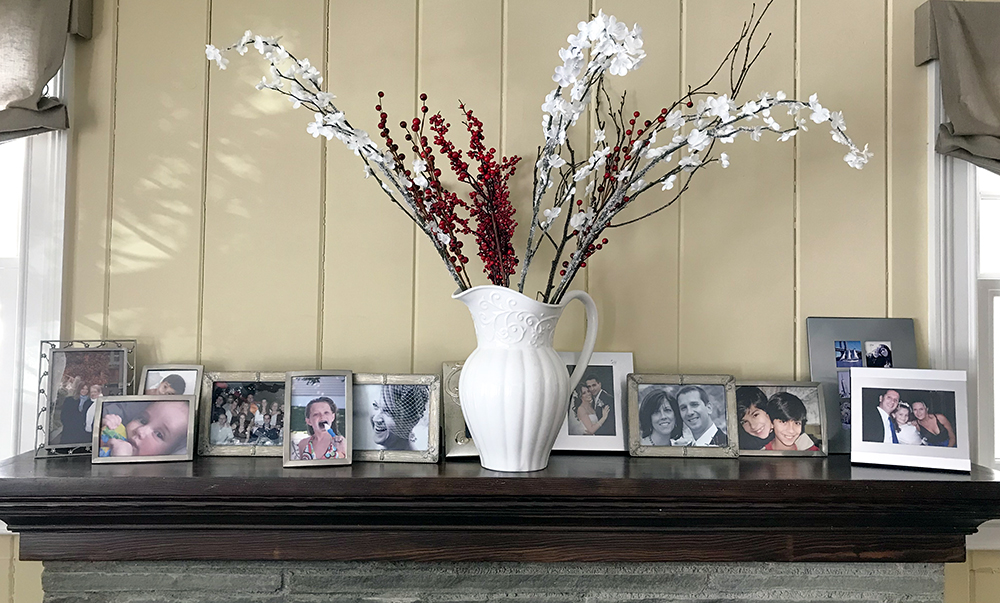Freeze frame
I have written often enough about the tragedy of digital photo hoarding and the importance of preserving our family archives for future generations. And I try to be on point about keeping up with the deluge of family photos from all our devices (deleting duds and dupes, backing up images to my hard drive for the annual family book). But I had a panicky realization recently:
Many of the photos most important to me are not, in fact, digitized at all, never mind backed up for safe keeping.
Yours too, I bet.
I am talking about the family photos that are right under our noses: the framed photos that adorn our walls and sit on our bookshelves. The ones we deemed special enough to display behind glass.
Take an inventory of framed photos
Once this occurred to me, I began to think of all the pictures around my house. Some of them, of course, derived from digital photos already—so those were likely backed up already, right? Well, depends…
A few things to consider to determine which photos you might want to digitize:
Professional photos shoots
(as from a wedding, family portrait session, or milestone event)
When were the photos taken?
If it was before 1990, the photos were almost definitely taken with a film camera.
If it was between the 1990s through the early 2000s, it’s a toss-up; both film and digital cameras were in common use.
If it was in the mid- to late-2000s, chances are your photographer shot digitally.
Anything taken after 2010 is almost certainly digital, unless you purposefully opted for a film photographer for the aesthetic (there is still a wonderful #filmisnotdead movement among photographers!).
Did you receive the high resolution images from the photographer, or just prints?
Many professional photographers charge a premium for handing over high-resolution digital files, so check your archives to make sure you have the shoot on your computer or external hard drive.
How did you receive the pictures? If it was via Dropbox or another software download site, note that most photographers do not leave files there indefinitely. The fine print in your contract would have stated when the link would expire, but that’s likely of little use to you now. Check, and ensure they are downloaded locally to your own system.
Original prints from a film camera
Old snapshots and Polaroids will fade over time, and may stick to the glass of everyday frames due to humidity. It’s important to find the best way to digitize those images without damaging originals.
Next up: digitizing project
Once you have a sense of how many framed photos are not backed up anywhere (sigh), it’s time to start digitizing. I recommend doing whatever you can to make the project more manageable, including, perhaps:
asking family members to help out
taking on the photos in one room per week
renting a scanner, ordering a pizza, and having a family reminiscing and preservation get-together (let the stories flow!)
at a minimum, using easy smart phone technology to immediately digitize those images you want to share and preserve (note, Google Photo Scan is an amazing option for this purpose, but it is not the answer for high-resolution files to use in a family history book, for instance)
hiring a professional such as myself to get the job done
Most important: Do something to ensure your precious family photos live on!
You considered them special enough to frame; now pay them the respect they deserve by backing them up.
Related Reading
Photographing Our Everyday: Our photos tell the stories of our lives—and our lives, frankly, are not merely birthdays & weddings. Our lives are lived in the in-between. Capture the moments.
Do Something Special with One Story: No one will tell your life stories but you. Five ideas for preserving one chapter of your life story.
The Photo Legacy You Leave Your Kids: Prepare your family photos so they provide comfort—not a burden—to your children when you're gone. It’s one of the most meaningful legacies you can leave your kids.
How to Use Photographs as Prompts for Writing Life Stories: A picture may be worth a thousand words, but when you actually attach words to a picture it gains even greater value.

